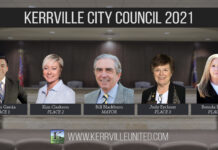With a unanimous vote at Tuesday night’s meeting, the Kerrville City Council adopted a brand new Zoning Code that includes some extensive changes to both the rules and the map. This adoption is the culmination of a year-long process of re-working the code by the Code Review Committee, the Planning & Zoning Commission, with input from the City Council, too.
Because of the multitude of changes in the new code, council admits that there will be issues that need to be addresses on a case-by-case basis, especially when it comes to nonconforming uses (when a property is being used for something that is not allowed in the new code). Council pointed out a six-month window during which property owners can bring up their objections with Drew Paxton, Executive Director of Development Services, and staff can begin to address those concerns.
Why is a zoning code important? A city’s zones establish where certain types of buildings, businesses, residences, factories, merchants, and service centers can operate, as well as how the buildings should look, what kind of parking they need to provide, and how the land use will fit within the larger surrounding neighborhoods and community as a whole. Zoning is one of the most important functions of a city’s planning department, which hopes to encourage responsible growth while protecting the quality of life for its current inhabitants. Cities are authorized to regulate zoning via Section 211 of the Texas Local Government Code.

Notable Changes
- Reduction in the number of zones from 49 to just 17
- Cleaning up and re-writing rules for clarity and user-friendliness
- Expansion of residential districts
- Changes to the Downtown Arts and Cultural District (DAC)
- Changes to land use table
- Changes to zoning map
Opposition
Several landowners spoke against the ordinance, stating their objections with regards to specific properties that they own, including former mayor Bonnie White. Council members answered these concerns by admitting that there might be issues that need to be addressed, but that it was important to move ahead with the new code to solve a multitude of other problems with the previous zoning ordinance, all the while providing a forum for property owners to air their grievances and discuss their problems with city staff.
Process
The process of creating the new Zoning Code has taken place over the past year, with numerous opportunities for citizens to attend open houses, public meetings, and workshops with the Code Review Committee (CRC), the P&Z Commission, and Council. The CRC met nine times in public meetings; the P&Z joined Council for a workshop in March; and a community open house was held in May. P&Z held a public hearing on August 13 and received public comments.
During all of these meetings and during this review period, the public was encouraged to provide feedback, comments, and suggestions. The city’s consultant also interviewed multiple stakeholders, business owners, landowners, and members of the general public. It is the opinion of this author that ample time and opportunity was given for public input, and we salute the city for their transparency during this process.
Next Steps
This was the second and final reading of this ordinance, so it is adopted as law. As noted, staff will work with individual property owners to address their concerns moving forward. And as always, P&Z and Council can grant variances and/or make changes to the code as needed in the future.
References
- Agenda packet for Tuesday night’s meeting (large PDF)
- New zoning map
- New zoning code (large PDF)
- New land use table
- City of Kerrville Planning Division
- City’s GIS Map with Zoning Districts
- Kerrville Daily Times article on August 28
Video
Written by Aaron Yates




